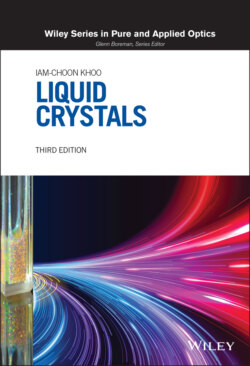Читать книгу Liquid Crystals - Iam-Choon Khoo - Страница 26
1.5.2. Cholesteric Liquid Crystal Cell Assembly
ОглавлениеCholesteric liquid crystals occupy a special niche in fundamental studies as well as optical applications owing to their photonic crystal properties. They are prepared in a similar fashion to the planar nematic sample, except that a small amount of chiral dopant is added to the starting nematic material [31]. Owing to the strong anchoring condition on the two cell windows, and the rotation ability of the chiral agent, the director axis of the CLC evolves as a spiral helix from one cell wall to the other, cf. Figure 1.11. In general, such helical arrangement of the director axis can be maintained by cell surfaces’ anchoring for sample thicknesses up to tens of microns; thicker cells invariably exhibit highly scattering focal conic texture associated with the helical axis becoming randomly oriented in bulk, cf. Figure 1.20a.
Recent studies [31–33] have shown that the so‐called field assisted self‐assembly (FASA) technique could produce very stable and well‐aligned CLC cells with thicknesses approaching 1 mm, with a period number N as large as 3000. The technique works by using nematic liquid crystals with negative dielectric anisotropy and a strong AC field during the sample preparation stage to enforce the required planar alignment of the LC molecules and therefore prevent the director axis rotation helix from deviation into a focal conic structure, as illustrated in Figure 1.20b and c. The empty cell is first filled with CLC mixture in the isotropic phase (see Figure 1.20b); then, as the sample is allowed to cool down slowly to room temperature, an AC electric (~2500 V; 1 kHz) is applied across the cell window for an extended period while the mixture sits at room temperature (Figure 1.20c and d).
Figure 1.20. (a) CLC with focal conic structure as a result of director axis deviating from planar alignment. (b) Random orientation of director axis in the isotropic liquid phase; AC voltage on. (c) Sample cooling down to ordered phase; strong AC field enforces planar alignment. (d) AC field removed after an extended period.
Figure 1.21. Left: Image of logo obstructed by a thin CLC cell with focal conic alignment. Right: Clear image viewed through a well‐aligned sample following the FASA treatment.
The fabricated cells are found to exhibit uniform planar alignment with low scattering loss, cf. Figure 1.21, and well‐defined photonic bandgaps with long‐ and short‐wavelength band‐edges that can be tailored to fit any wavelength in the visible to near‐rIR spectrum (400–2000 nm). The dispersion and other chiral photonic properties of these extraordinarily thick CLC’s have enabled advanced photonic processes such as ultrafast modulation of femtosecond laser pulses and polarization rotation/switching that are impossible with their conventional thin counterparts [31–33].
